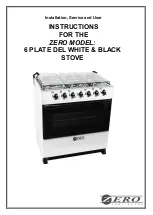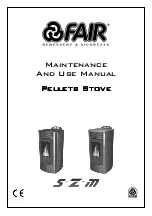
16
CHIMNEY CLEANING
The chimney should be cleaned twice annually or if
the stove is not used for a prolonged period during
the summer period, it should be cleaned prior to
commencement of usage. The chimney can be
cleaned through the stove depending on the flue
configuration and the flue liner should be cleaned in
accordance with manufacturer's instructions. Always
use a brush with plastic bristles that is the correct
size to reach all areas of the flue.
GLASS CLEANING
The stove glass will self-clean when there is suffi-
cient heat generated by the burning fuel i.e. when
the unit is operated at the maximum air settings. If a
build-up of creosote occurs on the glass it may be
due to low draft conditions, poor quality fuel or oper-
ating the stove at the minimum air settings for long
periods of time. The glass should be cleaned when
cool and cleaned with a non-abrasive cloth using
warm soapy water. For stubborn deposits, a grade 0
steel wool can be used whilst taking care not to
scratch the glass with any coal/ash deposits.
CLEANING A MATT BLACK/SENOTHERM
STOVE
Cleaning should be done when the stove is cold by
removing any dust or dirt using a dry cloth. Do not
use any water on the matt black/senotherm finish as
this will cause it to rust.
PROLONGED PERIODS OF NON USE
If the stove is to be left unused for a prolonged peri-
od of time then it should be given a thorough clean
to remove ash and unburned fuel residues. To
enable a good flow of air through the appliance to
reduce condensation and subsequent damage,
leave the air controls fully open.
It is important that the flue connection, any appliance
baffles or throat plates and the chimney are swept
prior to lighting up after a prolonged shutdown peri-
od.
WARNING NOTE:
Properly installed, operated and maintained this
stove will not emit fumes into the dwelling.
Occasional fumes from the de-ashing and re-
fuelling may occur. However, persistent fume emis-
sion is potentially dangerous and must not be toler-
ated. If fume emission does persist, then the follow-
ing immediate action should be taken:
(a) Open doors and windows to ventilate room.
(b) Let the fire out or eject and safely dispose of
fuel from the stove.
(c) Check for flue or chimney blockage and clean if
required.
(d) Do not attempt to relight the fire until the cause
of the fume emission has been identified and
corrected. If necessary seek expert advice.
The most common cause of fume emission is flue-
way or chimney blockage. For you own safety these
must be kept clean at all times.
PERIODIC MAINTENANCE
Rope Seal Replacement
Over time, the fire door latch can loosen due to the
continued compression and hardening of the seal
between the door and the front frame.
It is recommended that the rope seals are changed
at least every two years or sooner if the seal looses
its integrity.
Fig.18
Fig.19
TOP BAFFLE
CLIPS
Summary of Contents for Solis 80cm Single Sided Insert I80SS
Page 18: ...18 ELECTRICAL DIAGRAM...





































